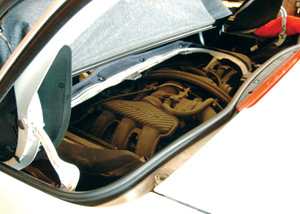I have been intrigued by automotive engineering and design since I was about 10 years old. The auto show was a big deal each year, and we always attended to get a chance to sit in some of the new cars from all over the world. In the 1950s, looking at the foreign cars was a big hit for me, simply because the small cars better matched my size, and they seemed to have fewer gadgets on them.
The dashboards had gauges and that was quite different than the American cars of that time; they just had “idiot” lights. I do remember, however, that the early cars from Porsche were a little different. The engine was in the back, there was no big grille on the front and there were very few gauges on the dash. Mostly just a speedometer and a tachometer, whatever they were for!
Times have changed since then, but my interest in automotive engineering still drives me to try and learn as much as I can about how stuff works, and why it was done a certain way. Today’s engineers and designers have a difficult balance to arrive at a vehicle that will meet government standards, look and drive well, and get reasonable fuel economy.
Porsche has been the leader in automotive design and engineering, for virtually all of my life. It has been building engines for decades that will literally fit in a suitcase, but are still able to put out horsepower that many larger engines can’t match.
In this article, I will present a few of the more common diagnostic challenges that we have seen with the Porsche Boxster, and prepare you to dive into one of these cars if it shows up on your lot. One of my favorite expressions concerning “exotic” cars is that, in fact, they are just cars. That Porsche is able to wrap all of the government-required bits into this tiny body and still make it look right on the outside is the ultimate expression of automotive engineering. Like candy with the perfect sugar coating and cream center.
The Basics
 The Porsche Boxster is a little different in layout than most cars, even other Porsche cars. It has been around for more than 10 years and its mid-engine design has been refined to the point that it is more than just an entry-level vehicle. The Boxster came along at a time when Porsche sales were falling, and with automated production methods has been a sales leader of the Porsche line.
The Porsche Boxster is a little different in layout than most cars, even other Porsche cars. It has been around for more than 10 years and its mid-engine design has been refined to the point that it is more than just an entry-level vehicle. The Boxster came along at a time when Porsche sales were falling, and with automated production methods has been a sales leader of the Porsche line.
Yearly changes have been kept to a minimum, but some significant changes have made the car more reliable. Most of this article will be aimed at the earlier models (1997 to 2000), as these cars are being snapped up by a lot of non-Porsche types looking for a fun, different kind of transportation.
For most repairs, all of the tools you would normally need to service other German-made cars are all that will be needed. In most cases, a scanner with OBD II and CAN bus capabilities will be sufficient to access codes for the drivetrain, but Porsche-specific software will be needed for body control modules and for reset procedures in the event of an electrical failure. Access to online or on-demand service information will be a big help as each year has some specific differences and updates that can help resolve faults.
For cooling system repairs, a vacuum filling system is highly recommended. A lot of wasted time can be eliminated by having the owners’ manual handy to allow access to the engine compartment, as there are a few steps necessary to partially open the top and remove the upper engine cover. There is an access panel behind the seats that provides room for repairs to the accessory drives at the front end of the engine.










